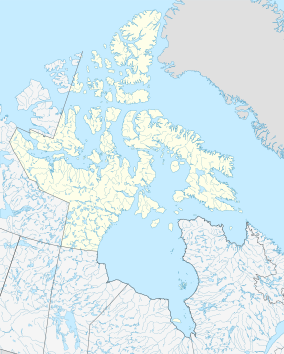Tuvaijuittuq Marine Protected Area
This article relies largely or entirely on a single source. (September 2020) |
| Tuvaijuittuq Marine Protected Area | |
|---|---|
 Location of Tuvaijuittuq MPA in Nunavut | |
| Location | Ellesmere Island, Nunavut, Canada |
| Nearest city | Alert (Canadian Forces base) Grise Fiord (hamlet) |
| Coordinates | 83°10′N 84°50′W / 83.167°N 84.833°WCoordinates: 83°10′N 84°50′W / 83.167°N 84.833°W |
| Area | 319,411 km2 (123,325 sq mi) |
| Designation | Marine Protected Area |
| Established | 21 August 2019 |
| Governing body | Fisheries and Oceans Canada |
| Website | Tuvaijuittuq MPA |
Tuvaijuittuq Marine Protected Area is a marine protected area located off the northwest coast of Ellesmere Island in Nunavut, Canada. The goal of the marine protected area is to protect the rich biodiversity and dynamism of the High Arctic sea ice ecosystem. Covering an area of 319,411 square kilometres (123,325 sq mi), Tuvaijuittuq is the largest protected area in Canada and among the largest protected areas in the world.[1] It is part of a large permafrost region called the Last Ice Area that covers the northern Greenland and the Canadian Arctic Archipelago.[2][3]
History[]
Tuvaijuittuq was established by ministerial order under the Oceans Act for interim protection on 21 August 2019. Under the order, no new or additional human activities will be allowed to occur in the area for up to five years while the Qikiqtani Inuit Association, the Government of Nunavut, and the Government of Canada work to establish long-term protection of the area. Exceptions to this rule include respecting Inuit rights to harvest wildlife under the Nunavut Agreement, scientific research, activities relating to national security and emergencies, and the safe passage of foreign ships through the region.[1]
Geography[]
The northwest coast of Ellesmere Island is dominated by thick, multi-year pack ice created by the circulation of the Beaufort Gyre.
Ecology[]
Sea ice provides habitat for ice-adapted organisms within the neritic and pelagic zones of the area, most notably ice algae. In addition, seabed communities in this area exhibits higher that expected levels of biodiversity and biological productivity.[1]
See also[]
References[]
- ^ a b c Government of Canada, Fisheries and Oceans Canada (2019-09-18). "Tuvaijuittuq Marine Protected Area (MPA)". www.dfo-mpo.gc.ca. Retrieved 2020-09-24.
- ^ Vincent, Warwick F.; Mueller, Derek (2020). "Witnessing ice habitat collapse in the Arctic". Science. 370 (6520): 1031–1032. doi:10.1126/science.abe4491. ISSN 0036-8075.
- ^ Kreier, Freda (2021-11-15). "Scientists are racing to save the Last Ice Area, an Arctic Noah's Ark". Science News. Retrieved 2021-12-05.
- Marine Protected Areas of Canada
- Nature reserves in Nunavut
- Protected areas established in 2019

